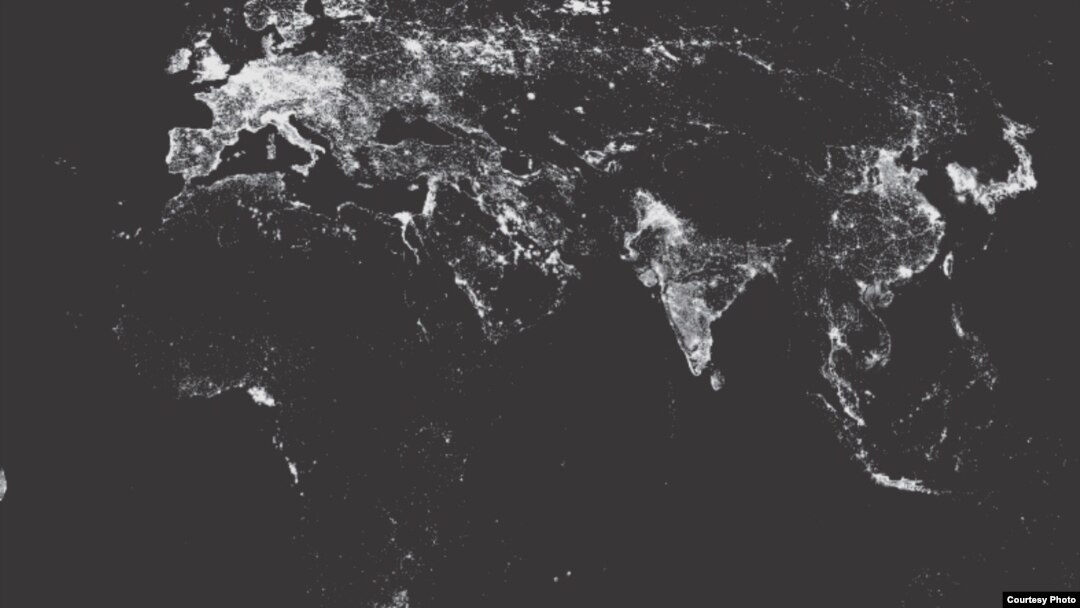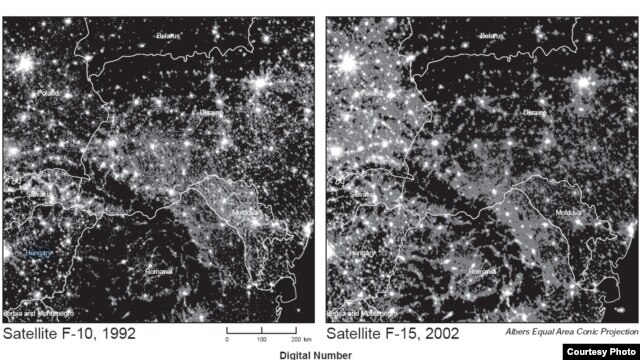Gross domestic product is one of the basic measures of economic well-being. It puts a value on all the goods and services produced in a country in a year.
But in some countries, it can be an inaccurate measure at best.
That could be because countries lack the infrastructure to gather quality data. Or because there's a lot of "informal" economic activity that isn't captured by official figures.
So how to improve on that?
Professor David Weil and two colleagues from Rhode Island's Brown University had an idea: Look at the night lights in satellite pictures.
Weil says that "as people get richer, they have the money to spend on light and demand more light," adding, "We also know that when they get rich enough, they demand infrastructure for electricity, not just for lights but for televisions, radios, refrigerators, and whatnot. So we see that as people get richer they do more activities at night, they drive at night, they get street lights and so on."
"In all these different ways the amount of light that people consume is an indicator of how wealthy people are," Weil says.
For instance, in his recent working paper, titled "Measuring Economic Growth From Outer Space," Weil and colleagues J. Vernon Henderson and Adam Storeygard show two satellite images of Eastern Europe taken 10 years apart.
The pictures show that light intensity increased dramatically in Hungary, Poland, and Romania between 1992 and 2002 -- matching those countries' rise in income.
Over the same decade, the lights dimmed substantially in Moldova and Ukraine, both of which saw drops in income and population.
On The Bright Side
Weil's study looked, over the same period, at some 40 countries ranked as having poor-quality GDP data.
The night lights suggest growth in some countries was slower than the official rate.
In Belarus, for instance, official figures say average annual growth was 1.6 percent. The lights say it was much slower -- 0.6 percent per year.
At the other end of the scale, the lights indicate the economic picture in Tajikistan perhaps wasn't as bad as official figures suggest. He calls Central Asia's poorest country "the second most extreme case in our data of a mismatch" after the Democratic Republic of Congo.
World Bank figures, which are based on Tajik government statistics, show GDP declining by 2.3 percent a year over the 11-year period that he studied.
"[But] what we see in the lights is the lights getting brighter at a rate that would be commensurate with GDP increasing by 1 percent per year over this period," Weil says. "So there's a more than 3-percent-per-year mismatch between what the lights say and what the official figures say."
Useful 'Tool'
The idea of using "proxy" methods to estimate growth is familiar to economic historians.
One cited in the paper looked at the number of letters mailed per person in various corners of the Austro-Hungarian Empire. Others have looked at skeletal remains to measure standards of living.
Weil says the "night light" proxy is useful in other ways.
It's much quicker to collect than standard statistics on economic growth.
It can show economic activity at a very localized level -- which towns, say, prosper with the discovery of a mineral deposit and how far that prosperity is spread.
Where national data is simply unavailable, "night light" can tell at least part of that country's economic picture.
Weil acknowledges that the method isn't perfect but argues that "it's a tool."
"It's never going to replace the standard methods for calculating GDP," Weil says, "but it's a fairly quick and dirty and cheap way of improving those estimates."
But in some countries, it can be an inaccurate measure at best.
That could be because countries lack the infrastructure to gather quality data. Or because there's a lot of "informal" economic activity that isn't captured by official figures.
So how to improve on that?
Professor David Weil and two colleagues from Rhode Island's Brown University had an idea: Look at the night lights in satellite pictures.
Weil says that "as people get richer, they have the money to spend on light and demand more light," adding, "We also know that when they get rich enough, they demand infrastructure for electricity, not just for lights but for televisions, radios, refrigerators, and whatnot. So we see that as people get richer they do more activities at night, they drive at night, they get street lights and so on."
"In all these different ways the amount of light that people consume is an indicator of how wealthy people are," Weil says.
For instance, in his recent working paper, titled "Measuring Economic Growth From Outer Space," Weil and colleagues J. Vernon Henderson and Adam Storeygard show two satellite images of Eastern Europe taken 10 years apart.
The pictures show that light intensity increased dramatically in Hungary, Poland, and Romania between 1992 and 2002 -- matching those countries' rise in income.
Over the same decade, the lights dimmed substantially in Moldova and Ukraine, both of which saw drops in income and population.
On The Bright Side
Weil's study looked, over the same period, at some 40 countries ranked as having poor-quality GDP data.
The night lights suggest growth in some countries was slower than the official rate.
In Belarus, for instance, official figures say average annual growth was 1.6 percent. The lights say it was much slower -- 0.6 percent per year.
At the other end of the scale, the lights indicate the economic picture in Tajikistan perhaps wasn't as bad as official figures suggest. He calls Central Asia's poorest country "the second most extreme case in our data of a mismatch" after the Democratic Republic of Congo.
World Bank figures, which are based on Tajik government statistics, show GDP declining by 2.3 percent a year over the 11-year period that he studied.
"[But] what we see in the lights is the lights getting brighter at a rate that would be commensurate with GDP increasing by 1 percent per year over this period," Weil says. "So there's a more than 3-percent-per-year mismatch between what the lights say and what the official figures say."
Useful 'Tool'
The idea of using "proxy" methods to estimate growth is familiar to economic historians.
One cited in the paper looked at the number of letters mailed per person in various corners of the Austro-Hungarian Empire. Others have looked at skeletal remains to measure standards of living.
Weil says the "night light" proxy is useful in other ways.
It's much quicker to collect than standard statistics on economic growth.
It can show economic activity at a very localized level -- which towns, say, prosper with the discovery of a mineral deposit and how far that prosperity is spread.
Where national data is simply unavailable, "night light" can tell at least part of that country's economic picture.
Weil acknowledges that the method isn't perfect but argues that "it's a tool."
"It's never going to replace the standard methods for calculating GDP," Weil says, "but it's a fairly quick and dirty and cheap way of improving those estimates."



